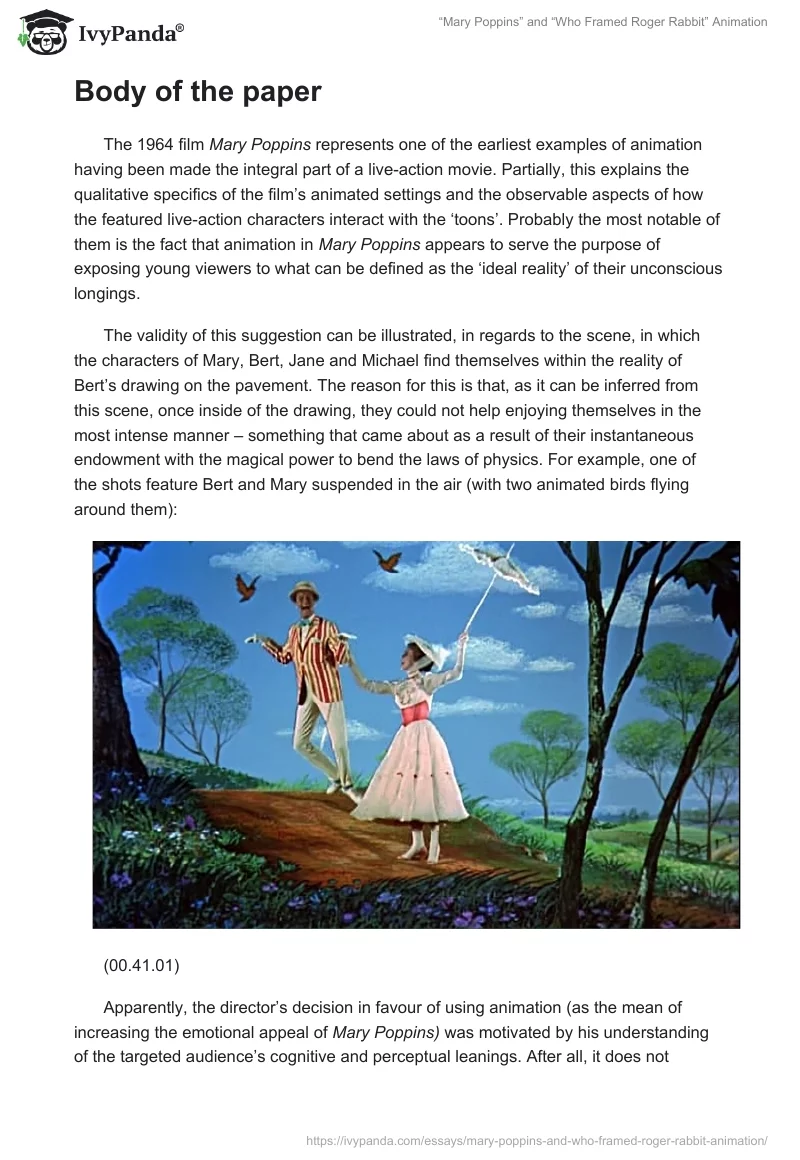Introduction
Up until comparatively recent times, it used to be a commonplace practice among many critics to refer to cinematography and animation, as two discursively incompatible modes of artistic representation. After all, whereas live-action movies are being concerned with the events that take place in the physical world, animated films expose us to the visual projections of the affiliated animators’ artistic conceptualisation of what this reality is, as an idea. As Wells pointed out: “If it is the live-action film’s job to present physical reality, animated film is concerned with metaphysical reality – not how things look, but what they mean”.
Moreover, it also used to represent a common assumption that, as opposed to cinematography, animation is a rather marginal medium of channelling artistic messages. This, of course, implied that animated films could not be discussed in terms of ‘high art’, by definition. According to Pilling: “Animation became defined by the Disney model – that of the cartoon as child/family entertainment, and as such, a no-go area for most film critics and theorists other than as material for ideological/sociological analysis”.
Nevertheless, as time goes on, more and more people grow to perceive animation as a thoroughly legitimate cinematic genre, which in turn can be explained by the fact that the animated mode of constructing the on-screen action is thoroughly consistent with the realities of a post-industrial living in the West.
In my paper, I will aim to substantiate the validity of this suggestion at length, in regards to the 1964 musical film Mary Poppins (directed by Robert Stevenson) and the 1988 live-action/animation film Who Framed Roger Rabbit (directed by Robert Zemeckis), while elaborating on what can be considered the discursive significance of both films. I will also promote the idea that the incorporation of animation in both of the mentioned films, is best discussed as such that is being consistent with people’s historically predetermined unconscious anxieties.
Body of the paper
The 1964 film Mary Poppins represents one of the earliest examples of animation having been made the integral part of a live-action movie. Partially, this explains the qualitative specifics of the film’s animated settings and the observable aspects of how the featured live-action characters interact with the ‘toons’. Probably the most notable of them is the fact that animation in Mary Poppins appears to serve the purpose of exposing young viewers to what can be defined as the ‘ideal reality’ of their unconscious longings.
The validity of this suggestion can be illustrated, in regards to the scene, in which the characters of Mary, Bert, Jane and Michael find themselves within the reality of Bert’s drawing on the pavement. The reason for this is that, as it can be inferred from this scene, once inside of the drawing, they could not help enjoying themselves in the most intense manner – something that came about as a result of their instantaneous endowment with the magical power to bend the laws of physics. For example, one of the shots feature Bert and Mary suspended in the air (with two animated birds flying around them):
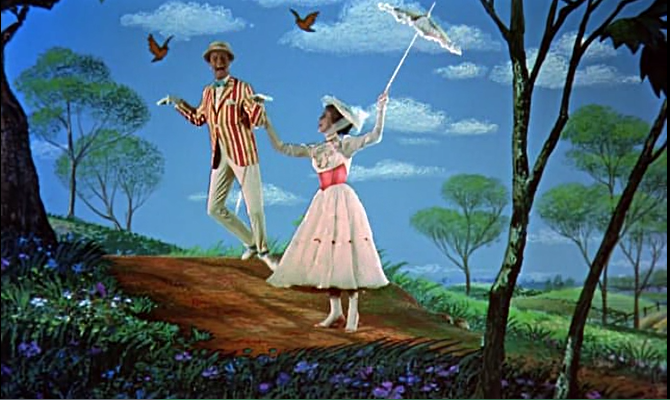
Apparently, the director’s decision in favour of using animation (as the mean of increasing the emotional appeal of Mary Poppins) was motivated by his understanding of the targeted audience’s cognitive and perceptual leanings. After all, it does not represent any secret that children do tend to indulge in daydreams, while constructing the ‘reality’ of their own, where the dialectical ‘cause-effect’ principle does not quite apply. This, of course, establishes Marry Poppins as a film that aims to primarily appeal to the adolescent audiences.
There is another notable characteristic of how Stevenson went about integrating the elements of animation in his film. It is concerned with the animated characters’ tendency to act in the way that confirms the validity of the class-based outlook on how just about any society operates. To exemplify the soundness of this suggestion, we can refer to the scene, in which animated butler-penguins serve Mary and Bert at the table:
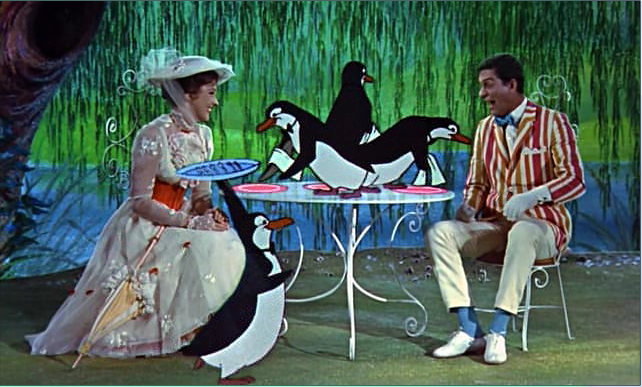
The reason for this is that, throughout the scene’s entirety these penguins tend to exhibit way too much enthusiasm, while to trying to please Mary and Bert, as something that has the value of a ‘thing in itself’. This provides us with a rationale to suggest that the primary function of Stevenson’s deployment of animation in his film had to do with the director’s intention to have a number of purely abstract ideas ‘embodied’ as animated characters – something that could be hardly achieved, had he chosen in favour of sticking with the conventional (live-action) cinematic format.
For example, the earlier mentioned penguins epitomise the idea of subservience in terms of one’s biologically predetermined mental trait. In its turn, this leaves only a few doubts that Mary Poppins was produced prior to the advent of political correctness, as the governmentally endorsed policy in the West. In this respect, it will prove rather impossible to disagree with McLeer, who aptly observed that: “All films, whatever their historical setting, always speak to the moment of their production in some way”.
Apparently, Stevenson strived to ensure that his film would not only entertain viewers, but also educate them about the main conventions of what used to be the predominant socio-cultural discourse at the time of this film’s creation. The medium of animation came in particularly handy, in this respect, because it makes possible the visual representation of the essentially metaphysical notions and ideas.
For example, throughout the course of the sixties, the relationship between men and women used to be discussed within the context of what happen to be the socio-biological ‘calling’ of the representatives of both genders. Consequentially, this presupposed that it is specifically the factor of sexual tension, which defines the essence of social interactions between men and women. Because Mary Poppins fits the category of a ‘family film’, the director was not in the position to present Mary as being no stranger to flirting with the film’s male-characters.
Yet, in order to ensure Mary’s ‘three-dimensionality’, as a character, the director did need to accentuate the sheer power of her sex appeal. Here, animation again came as an indispensable asset. The reason for this is that, while utilising the representational medium in question, Stevenson was able to enlighten young viewers on what the relationship between the representatives of opposite sexes is supposed to be all about, without fearing that his film would be ostracized by the spokesmen of America’s ‘moral majority’. In this respect, the below-screenshot is particularly illustrative:
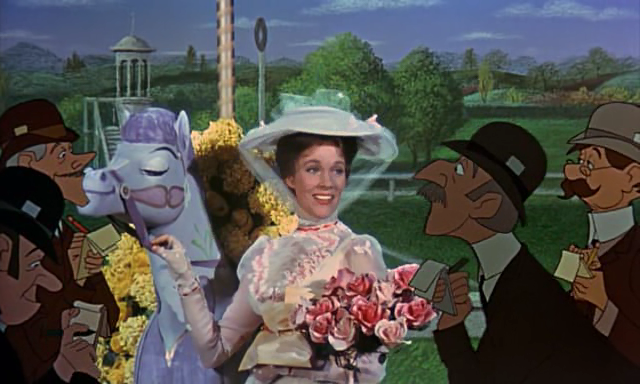
After all, as it can be seen on it, the animated characters that surround Mary do not only appear to be dimensionally, but also psychologically ‘flat’. The reason for this is that, if there is anything particularly memorable about them, it would be the lustful expressions of their faces.
In light of what has been said earlier, the actual role of animation in Mary Poppins appears quite clear – it is there to enable the featured ‘physical’ characters to interact with the highly abstract notions, which in turn adds rather substantially to the film’s educational value.
Essentially the same line of argumentation can be applied, when it comes to discussing the discursive significance of the 1988 live-action/animation film Who Framed Roger Rabbit. After all, most of the animated characters in this film indeed appear to be reflective of the stereotypical conceptualizations of one’s existential identity.
There is, however, even more to it. Whereas, in Stevenson’s film animation plays a rather secondary role, within the context of how this film’s semiotics are being constructed, in Who Framed Roger Rabbit it actually defines the quintessence of the explored themes and motifs. This simply could not be otherwise, because as opposed to what it appears to be the case with Mary Poppins, Zemeckis’s film is closely affiliated with the discourse of post-modernity. As Silverman noted: “Who Framed Roger Rabbit is a postmodern film – or if that is too radical a claim, it certainly operates postmodern principles.
It is marked with postmodern effects. It is marked by postmodernism”. The legitimacy of this suggestion can be shown, in regards to the fact that, unlike Stevenson, Zemeckis treats his animated characters as being fully capable of exhibiting a number of seemingly incompatible psychological traits. The only difference between these characters, on one hand, and the conventional ones, on the other, is that the former appear to behave in the emotionally hypertrophied manner. For example, after having found out about his wife’s marital infidelity, the animated character of Roger Rabbit becomes emotionally distressed to such an extent that he is shown about to explode:
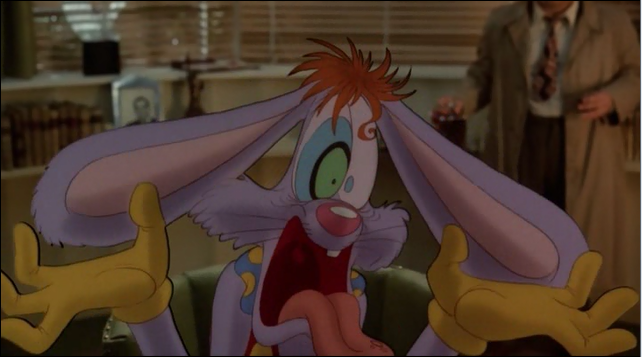
However, the mentioned behaviour pattern, on the part of these characters, is thoroughly justified, because their presence in Who Framed Roger Rabbit is meant to prompt viewers to get in touch with their own unconscious anxieties, reflected by the film’s discursive overtones. The main of these anxieties has to do with the fact that, as time goes on, more and more people get to realise that, due to being subjected to the continually intensified informational transactions (brought about by the recent breakthroughs in the field of IT), they can no longer consider themselves endowed with a single existential identity.
Rather, their personalities are made out of the conglomerate of often incompatible identity-related notions. Therefore, it will be much more appropriate to refer to the animated characters in Zemeckis’s film as such that do not incarnate a single stereotypical individuality, but rather a few of these individualities at the same time: “Roger is already a parody of himself.
Roger is already postmodern. Roger is a parody of himself but also of all those films which themselves reflect upon film-making”. The same can be said about the character of Roger’s wife Jessica Rabbit. Apparently, she does not only represent the theme of ‘femme fatale’ in Who Framed Roger Rabbit – Jessica acts as a ‘composite character’, who synthesises the physical looks and the behavioural traits of just about every ‘femme fatale’, seen in the ‘noir’ films of the forties and fifties:
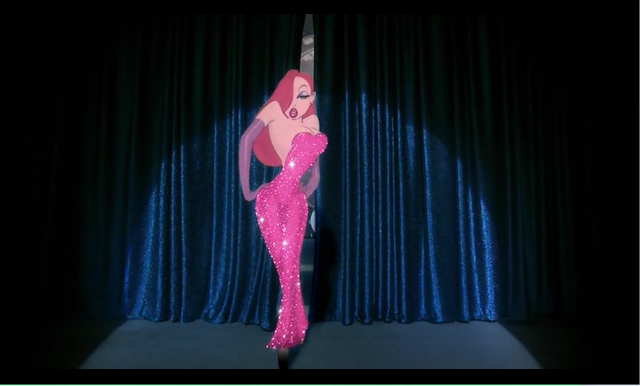
It is understood, of course, that the achievement of the described dramatic effect would prove impossible, had the director decided to entrust the task of embodying a few ‘femme fatales’ at the time to a ‘human’ actor. The reason for this is quite apparent – live-action actors always perform in the way consistent with what happened to be their own self-image, which in turn effectively disqualifies them from being able to act as merely the ‘synthets’ of the individualities of other people.
In this respect, the medioum of animation provides the director with many additional expressive opportunities – something that is being predetermined by the fact that animation is essentially ‘collective art’, concerned with subverting the reality. This, in turn, is being done for the purpose of helping viewers to gain a better understanding of the referential subjects of animation, as ‘things in themselves’: “Animation, as an instrument of science, creates the illusion of life for the purpose of illustrating the ‘real thing’”.
Thus, it will be thoroughly appropriate, on our part, to suggest that the live-action/animation format of Who Framed Roger Rabbit extrapolates the director’s awareness of the fact that the actual realities of post-modernity, closely associated with the discourse of cultural relativism, naturally cause the gap between the genres of animation and live-action cinematography to grow increasingly thinner.
Conclusion
Based upon what has been argued earlier, in regards to the films Mary Poppins and Who Framed Roger Rabbit, we can formulate the following conclusions, relevant to the discussed subject matter:
- The very fact that the directors of both films succeeded in morphing the live-action performance of ‘human’ actors with that of the featured animated characters, implies that the genres of animation and cinematography are not only closely related, but that they organically derive out of each other. As Bouldin pointed out: “The hybrid film (live-action/animation) challenges the notion that there is any such thing as ‘true’ live-action or ‘true’ animation, deconstructing the specious assumption that the two are somehow opposites”. Partially, this explains why the films in question proved commercially successful. Apparently, viewers are naturally driven to regard the morphing of cinematic live-action with animation in terms of a fully justified directorial move.
- The continual progress in the field of IT presupposes that, as time goes on, the elements of animation will be increasingly used in conventional live-action films. The validity of this claim can be confirmed, in regards to the current trend of this type of films becoming ever more associated with the deployment of computer-generated special effects: “All cinema is going to become a form of animation… It is really a question of time”. This eventual scenario is predetermined by the fact that, as it was suggested earlier, the discourse of post-modernity opposes the practice of cinematic genres being provided with the conceptually rigid definitions.
I believe that these conclusions fully correlate with the paper’s initial thesis. Apparently, there is indeed a good reason to expect the continual incorporation of animation in live-action films, as the mean of increasing their emotional appeal. Moreover, due to what has been mentioned earlier, we can expect the eventual emergence of an entirely new cinematic genre, concerned with exploring the previously unheard-of morphing possibilities between animation and live-action cinematography.
Bibliography
Bouldin, Joanna. “The Animated and the Actual: Toward a Theory of Animation, Live-Action, and Everyday Life.” Order No. 3132381, University of California, Irvine, 2004.
Cholodenko, Alan. “Who Framed Roger Rabbit, Or the Framing of Animation.” in The Illusion of Life: Essays on Animation, ed. Alan Cholodenko. Sydney: Powers Publications, 1991.
Diprose, Rosalyn and Cathryn Vasseleu. “Animation—AIDS in Science/Fiction.” in The Illusion of Life: Essays on Animation, ed. Alan Cholodenko. Sydney: Powers Publications, 1991.
Mary Poppins. DVD. Directed by Robert Stevenson. 1964: Walt Disney Productions.
McLeer, Anne. “Practical Perfection? The Nanny Negotiates Gender, Class, and Family Contradictions in 1960s Popular Culture.” NWSA Journal: National Women’s Studies Association Journal 14, no. 2 (2002): 80-101.
Pilling, Jayne “Introduction.” in A Reader in Animation Studies, ed. Jayne Pilling. London: John Libbey, 1997.
Sammond, Nicholas. “A Space Apart: Animation and the Spatial Politics of Conversion.” Film History 23, no. 3 (2011): 268-284.
Silverman, Hugh. “The Mark of Postmodernism: Reading Roger Rabbit.” Cinemas: Revue d’Études Cinematographiques = Journal of Film Studies 5, no. 3 (1995): 151-197.
Sobchack, Vivian. The Address of the Eye: a Phenomenology of Film Experience. Princeton: Princeton University Press, 1992.
Thompson, Kristin. “Implications of the Cell Animation Technique.” in The Cinematic Apparatus, ed. Teresa De Laurentis and Stephen Heath. St. Martin’s Press, 1980.
Vognar, Chris. “Suddenly, Animation is Everywhere: Fantasy Overtaking Reality in Film.” The Ottawa Citizen, 2001.
Wells, Paul. Understanding Animation. London: Routledge, 1998.
Who Framed Roger Rabbit. DVD. Directed by Robert Zemeckis. 1988: Touchstone Pictures/Amblin Entertainment.


